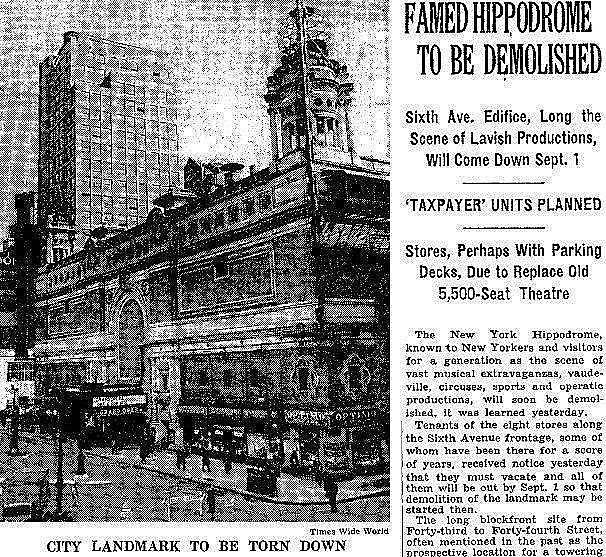So the New-York Historical Society has an exhibit running through the end of September called Lost New York. It covers some of the classic lost buildings, like the much-mourned first Pennsylvania Station, and lost city practices, like the now-icky idea of swimming in the East River.
George Bellows, Forty-Two Kids (1907), National Gallery of Art, Corcoran Collection (Museum Purchase, William A. Clark Fund)
Of course the Hippodrome joins the roll call of lost places and practices. It was in such a central location in Midtown Manhattan, and its shows were seen by so many people. The website mentions a “Broadway carpenter” who reminisces about his father going to the Hippodrome. If anyone gets a chance to see the exhibit, please share pictures and responses! I know that newspaper reporters and writers got super nostalgic about the Hippodrome being demolished once its fate was decided in the summer of 1939. I’ll be writing a bit more about that for the upcoming anniversary of its final shows in August. You can see a clipping from a typical story below.
New York Times, July 1, 1939, page 19.
What I want to talk about a bit more today, though, is the weird way that people kept imagining the loss of the Hippodrome well before it was actually torn down. One of the first columns that I found that dealt with this topic was a New Yorker column by “T.H.B.” a pseudonym for Tyler Howe Bliss, known as “Tip,” who was managing editor for the magazine in its early days. Filling in the space between a goofy parody of college athletics and a shockingly good listing of theatrical offerings, Bliss writes “A Brief History of the Hippodrome”:
“April 12, 1905 — Grand opening of the New York Hippodrome.
April 13, 1905 — First rumors that the New York Hippodrome is to be torn down to make room for an office building.
April 14, 1905 — Positive confirmation of rumors that the New York Hippodrome is to be torn down to make room for an office building.
April 15, 1905 — Editorial denunciation in all the newspapers of the fact that the New York Hippodrome, one of the historic old landmarks of the city, is to be torn down to make room for an office building.
April 16-22, inclusive, 1905 — Bitter, tearful, cunical and semi-humorous comment by newspaper columnists over the fact that the New York Hippodrome, one of the historic old landmarks of the city, is to be torn down to make room for an office building.
April 23, 1905 — Official announcement that the New York Hippodrome is *not* to be torn down to make room for an office building.
April 12-22, inclusive, 1906-1925, also inclusive — Follow formula.
April 23, 1925 — Official announcement that the New York Hippodrome is *not* to be torn down to make room for an office building, but has been purchased by E.F. Albee, and the present policy is to be pursued in perpetuity.
April 24, 1925 — Editorial writers and columnists mark their denunciatory, bitter, tearful, cynical and semi-humorous articles “stet” in preparation for 1926.”
Obviously the fears about the Hippodrome being torn down didn’t really go back to the day after it opened, but they were recurrent. Whenever the management changed hands — from Fred Thompson and Skip Dundy to the Shuberts and Max C. Anderson, from the Shuberts to Charles Dillingham, and from Dillingham to Albee — there came a moment before the deal was done when people joked that the Hippodrome was a white elephant in its current state and speculated about the site’s potential. The Hip producers typically produced a one-off special show every spring on the anniversary of its opening; the one they put on April 12, 1923 was called the 18th and Final Anniversary. They paid tribute to founder Fred Thompson, who died 4 years earlier, with his widow in attendance. In a sense it was the final anniversary of the Hippodrome as it was. When Albee bought the theater, he had architect Thomas W. Lamb “renovate” it into a far more standard vaudeville house. Lamb eliminated 400 seats and (gasp) removed the water tank beneath the stage apron so the proscenium stage extended closer to the audience. That’s when my Hippodrome was lost.

